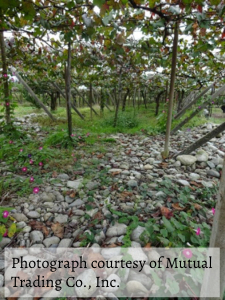Koshu Wine – Uniquely Indigenous to Japan
When it comes to Japanese alcoholic beverages, most people think of sake. But in recent years, sommeliers around the world have been becoming curious about another: the indigenous wines of Japan, namely those from Koshu.
In terms of climate, Japan isn’t really suitable for growing wine grapes due to its volatile weather, prevailing overcast days and plentiful rainfall. But there is one place where wine grapes do thrive: the Koshu region in Yamanashi Prefecture. Protected by high mountains on all sides, Koshu is prone to pleasant sunny conditions and low precipitation, making it the most conducive spot to cultivate wine grapes in Japan.
That goes for the soil too. While most of Japan’s soil is too fertile to grow wine grapes, Koshu’s has rapid drainage that provides the low nutrient conditions ideal for crops. The quick drainage stems from the region’s steep slopes and the high density of basalt and andesite, or volcanic rocks with poor water retention, in the soil. These conditions make it possible for wine-grape plants to extend their roots deep into the layers of various soil compositions to absorb nutrients, in turn improving the flavor of the wine.
Yamanashi growers use the laborious pergola trellising method, in use since the Edo period (1603-1868), to dissipate humidity buildup that can cause mold growth. To protect crops from occasional hailstorms and ward off birds, growers carefully enfold each grape cluster with white paper or plastic mini-umbrellas.

Below the pergola trellis, volcanic rocks cover the grounds at Issehara Vineyard. Minerals and nutritional components in the soil make Aruga Branca Issehara Wine, a one-of-a-kind, Grand Vin of Japan.
Koshu grapes are much larger than European wine grape varieties, and also have thinner skins and less grape seed extract. This yields a delicate and elegant flavor. Genetic analysis conducted by the University of California, Davis in 2004 found that the Koshu grape variety is the same as Vitis vinifera, a common grape vine. This explains why Koshu wine grapes taste very similar to Albariño, Pinot Grigio, Pinot Blanc white wine grapes and sometimes Sauvignon Blanc.
Koshu wine is well balanced and pairs exceptionally well with the delicate flavors of Japanese food, even Californian and modern cuisine. This may be why Koshu wines have come into the limelight, lining up along their more established counterparts from the Western world. tj

Aruga Branca: Brilhante Aroma of white flower, pear compote, dry leaves; simple flavor [Katsunuma Winery]

Aruga Branca Issehara: Grapefruit, white peach and tropical fruits on nose; fruity and full bodied [Katsunuma Winery]

Arugano Bosque: Grapefruit, pear, quince on nose; fruits with a hint of mineral and acid [Katsunuma Winery]

Katsunuma Koshu: Rising aromas of citrus and stone fruits with crisp acidity [Mercian]
The complete article can be found in Issue #279 of the Tokyo Journal.





